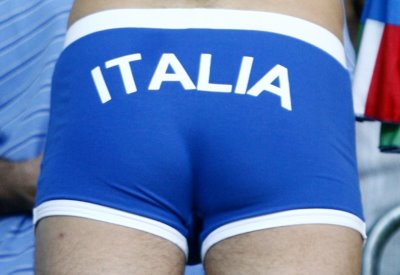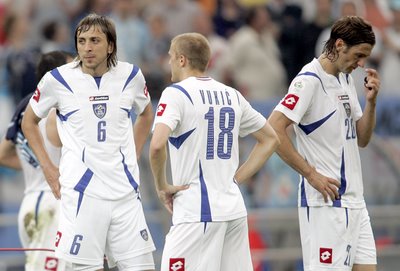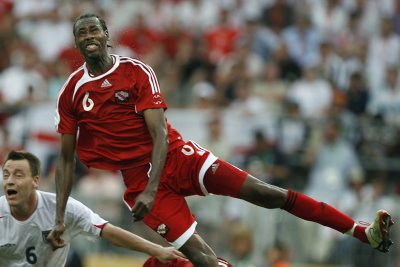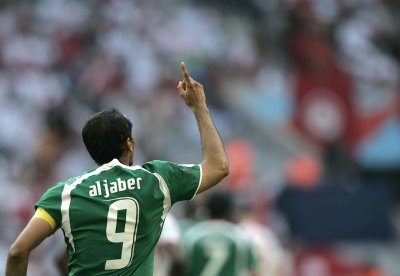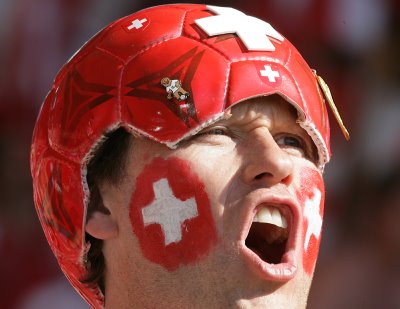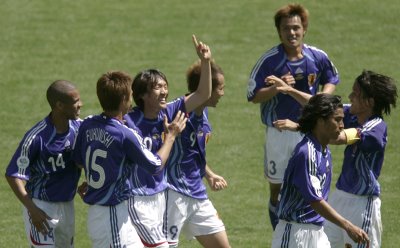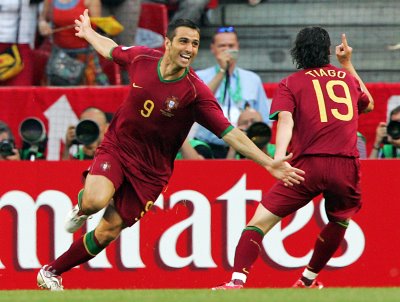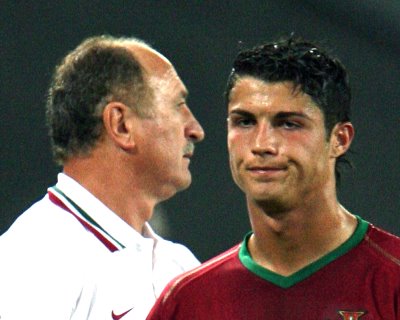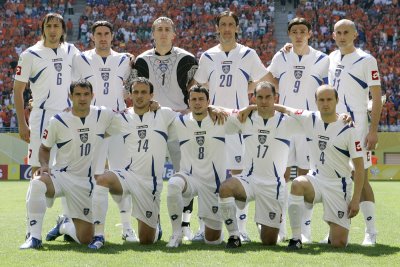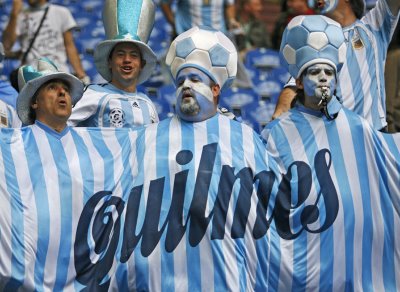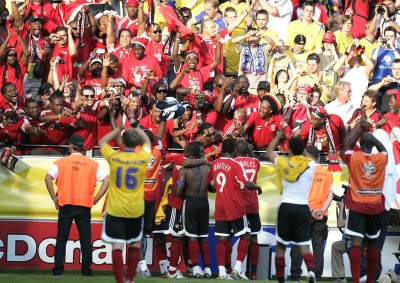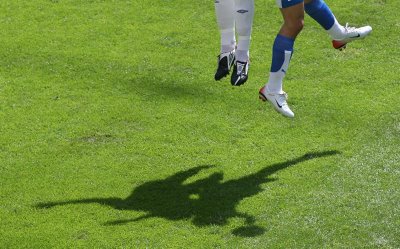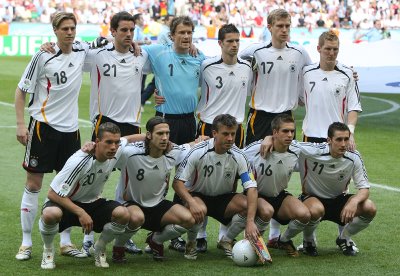A quest for perfection for the most basic thing: A ball
By Alice Rawsthorn International Herald Tribune
Published: June 25, 2006
LONDON Things did not bode well. The German goalkeeper Jens Lehmann complained it was "unpredictable." His counterpart from England's team, Paul Robinson, dismissed it as "goalkeeper unfriendly." Brazil's strikers found it so tricky that they scheduled extra training sessions. Even before the World Cup had started, players were voicing concerns about the official ball, Adidas's multimillion dollar +Teamgeist.
Burdened by a pompous name (the German word for team spirit) with a silly + as a prefix and Adidas's lofty claims that it was the smoothest, roundest and most accurate soccer ball ever, the +Teamgeist seemed set to become the joke of the 2006 World Cup. Its prospects were not helped by the fact that many of the correspondents flocking to Germany remembered that Adidas made startlingly similar statements four years ago when it unveiled the Fevernova ball for the 2002 tournament.
How has the +Teamgeist performed since the World Cup started? Is it living up to Adidas's claims? Or fulfilling the players' fears? Goalies are still grumbling, but to the surprise of cynics, the new ball does seem to be livening up the game.
"It's always tempting to dismiss innovations in ball design as marketing hype, but this one is creating more excitement," said Jack Huckel, director of museum and archives at the National Soccer Hall of Fame in Oneonta, New York. "It can be shot from longer distances with greater impact and bent at greater speed. You see it exploding off the players' feet. I've tried it out and you feel the difference. Though, as a former goalkeeper, I understand why they don't like it."
The commercial importance of the World Cup ball to Adidas is obvious. How many other products are launched as part of one of the world's most popular events to a global television audience of hundreds of millions of enthralled fans? Adidas pays millions of dollars to be the official ball supplier to the World Cup in the hope of creating a bestseller. Having sold a record six million of the Fevernova ball of 2002, it has even higher expectations of the +Teamgeist.
It is harder to understand why designing a soccer ball should be so daunting. After all, it is a ball. How hard can it be to design a round object of a specific size and weight? The challenge the sports industry's designers, engineers and scientists have struggled with for decades is to produce a ball in so robust a form that it enhances, rather than inhibits, the quality of play by behaving in exactly the same way wherever and whenever it is kicked.
From the late 1800s to 1970, soccer balls consisted of 18 hand-stitched brown leather panels. During the 1966 World Cup, viewers complained they could not follow the ball on their black-and-white television screens, and FIFA, the world governing body of soccer, commissioned Adidas to design a television-friendly alternative. The result was the Telstar with 32 leather panels - 12 black pentagons and 20 white hexagons. Launched at the 1970 World Cup in Mexico, it has been the default design for soccer balls ever since.
Adidas has since developed a new ball for every World Cup with varying degrees of success. A notable flop was the Tango España of 1982 with rubber inlaid over the seams. The rubber rubbed off when the ball was kicked, and each ball had to be replaced during the match. More successful was the Questra of 1994, whose polyurethane foam coating made it faster in flight. All of these balls adopted the 32-panel format, as did the Fevernova.
"After so many years of 32 panels, we decided to try something completely different for 2006, and chose a 14-panel structure," said Hans-Peter Nürnberg, who led the +Teamgeist design team for Adidas as senior development engineer. "By reducing the number of panels and the length of seams, we made it rounder, better balanced and therefore more accurate."
The new ball has two layers, inner and outer, with a new thermal bonding technology used to create a seamless surface.
Adidas's rationale is that this makes the ball more consistent because the impact of the player's foot will be the same wherever it strikes the surface. As there are no seams, the ball does not absorb moisture during the game and thereby stays the same weight. The +Teamgeist is slightly heavier than an unused Fevernova but weighs less than a Fevernova that has been used for a whole match, as it has not retained water. This too ensures that it behaves in the same way throughout the game.
Adidas subjected the +Teamgeist to intensive laboratory and field tests before putting the ball into production last July. Nürnberg said it exceeded expectations in the tests, which included repeated kicking by a robotic leg to replicate the 2,000 kicks it would endure in a typical World Cup match and rotating the ball 250 times under water. Even so, the toughest test for a soccer ball is its performance in a match.
After the first stage of the World Cup, observers are convinced that the +Teamgeist can be kicked more powerfully from longer distances. Torsten Frings's goal for Germany against Costa Rica was an example, as was Tomas Rosicky's first goal for the Czech Republic against the United States. Similarly, the swerve of the ball is accentuated as it bends to the left or right. "The bend is more dramatic," affirmed David James of Sheffield Hallam University's sports engineering department. "This ball is great for players like David Beckham, at least it should be." Another factor, analyzed by his colleagues at the University of Sheffield, is the +Teamgeist's tendency to swerve from side to side before hitting the back of the net when it is kicked straight without spin.
All of this makes life tougher for goalkeepers, as they face stronger shots and unexpected swerves. As matches progress, these problems are aggravated by the +Teamgeist's lightness, which makes it harder to catch. "It's so light that it slips out of your hands," Huckel noted. "That's why we see more goalkeepers thumping the ball away rather than trying to catch it."
The +Teamgeist also has a tendency to confuse goalies by wavering as it hurtles towards them. James attributes this to the aerodynamic complexity of its shape. "We're at the cutting edge of science here because we understand more about the aerodynamics of airplanes and Formula One cars than of spheres," he said. "A perfect sphere moves through the air with considerable difficulty, which is why sports balls tend to have rough surfaces. The felt on tennis balls and dimples on golf balls improves their aerodynamics and helps them to move faster." The seams on the old 32-panel soccer balls had the same effect, whereas the seamless +Teamgeist bobs about disconcertingly, like a milder version of a knuckleball in baseball.
Despite the goalies' grumbles, the +Teamgeist has proved even more popular than Adidas expected, setting a new sales record of 15 million balls so far. Nürnberg's design team is already working on its successor. "We need to erase the imperfections in its structure," he said. "Although we can't expect to produce something as revolutionary as the +Teamgeist for every World Cup."
Published: June 25, 2006
LONDON Things did not bode well. The German goalkeeper Jens Lehmann complained it was "unpredictable." His counterpart from England's team, Paul Robinson, dismissed it as "goalkeeper unfriendly." Brazil's strikers found it so tricky that they scheduled extra training sessions. Even before the World Cup had started, players were voicing concerns about the official ball, Adidas's multimillion dollar +Teamgeist.
Burdened by a pompous name (the German word for team spirit) with a silly + as a prefix and Adidas's lofty claims that it was the smoothest, roundest and most accurate soccer ball ever, the +Teamgeist seemed set to become the joke of the 2006 World Cup. Its prospects were not helped by the fact that many of the correspondents flocking to Germany remembered that Adidas made startlingly similar statements four years ago when it unveiled the Fevernova ball for the 2002 tournament.
How has the +Teamgeist performed since the World Cup started? Is it living up to Adidas's claims? Or fulfilling the players' fears? Goalies are still grumbling, but to the surprise of cynics, the new ball does seem to be livening up the game.
"It's always tempting to dismiss innovations in ball design as marketing hype, but this one is creating more excitement," said Jack Huckel, director of museum and archives at the National Soccer Hall of Fame in Oneonta, New York. "It can be shot from longer distances with greater impact and bent at greater speed. You see it exploding off the players' feet. I've tried it out and you feel the difference. Though, as a former goalkeeper, I understand why they don't like it."
The commercial importance of the World Cup ball to Adidas is obvious. How many other products are launched as part of one of the world's most popular events to a global television audience of hundreds of millions of enthralled fans? Adidas pays millions of dollars to be the official ball supplier to the World Cup in the hope of creating a bestseller. Having sold a record six million of the Fevernova ball of 2002, it has even higher expectations of the +Teamgeist.
It is harder to understand why designing a soccer ball should be so daunting. After all, it is a ball. How hard can it be to design a round object of a specific size and weight? The challenge the sports industry's designers, engineers and scientists have struggled with for decades is to produce a ball in so robust a form that it enhances, rather than inhibits, the quality of play by behaving in exactly the same way wherever and whenever it is kicked.
From the late 1800s to 1970, soccer balls consisted of 18 hand-stitched brown leather panels. During the 1966 World Cup, viewers complained they could not follow the ball on their black-and-white television screens, and FIFA, the world governing body of soccer, commissioned Adidas to design a television-friendly alternative. The result was the Telstar with 32 leather panels - 12 black pentagons and 20 white hexagons. Launched at the 1970 World Cup in Mexico, it has been the default design for soccer balls ever since.
Adidas has since developed a new ball for every World Cup with varying degrees of success. A notable flop was the Tango España of 1982 with rubber inlaid over the seams. The rubber rubbed off when the ball was kicked, and each ball had to be replaced during the match. More successful was the Questra of 1994, whose polyurethane foam coating made it faster in flight. All of these balls adopted the 32-panel format, as did the Fevernova.
"After so many years of 32 panels, we decided to try something completely different for 2006, and chose a 14-panel structure," said Hans-Peter Nürnberg, who led the +Teamgeist design team for Adidas as senior development engineer. "By reducing the number of panels and the length of seams, we made it rounder, better balanced and therefore more accurate."
The new ball has two layers, inner and outer, with a new thermal bonding technology used to create a seamless surface.
Adidas's rationale is that this makes the ball more consistent because the impact of the player's foot will be the same wherever it strikes the surface. As there are no seams, the ball does not absorb moisture during the game and thereby stays the same weight. The +Teamgeist is slightly heavier than an unused Fevernova but weighs less than a Fevernova that has been used for a whole match, as it has not retained water. This too ensures that it behaves in the same way throughout the game.
Adidas subjected the +Teamgeist to intensive laboratory and field tests before putting the ball into production last July. Nürnberg said it exceeded expectations in the tests, which included repeated kicking by a robotic leg to replicate the 2,000 kicks it would endure in a typical World Cup match and rotating the ball 250 times under water. Even so, the toughest test for a soccer ball is its performance in a match.
After the first stage of the World Cup, observers are convinced that the +Teamgeist can be kicked more powerfully from longer distances. Torsten Frings's goal for Germany against Costa Rica was an example, as was Tomas Rosicky's first goal for the Czech Republic against the United States. Similarly, the swerve of the ball is accentuated as it bends to the left or right. "The bend is more dramatic," affirmed David James of Sheffield Hallam University's sports engineering department. "This ball is great for players like David Beckham, at least it should be." Another factor, analyzed by his colleagues at the University of Sheffield, is the +Teamgeist's tendency to swerve from side to side before hitting the back of the net when it is kicked straight without spin.
All of this makes life tougher for goalkeepers, as they face stronger shots and unexpected swerves. As matches progress, these problems are aggravated by the +Teamgeist's lightness, which makes it harder to catch. "It's so light that it slips out of your hands," Huckel noted. "That's why we see more goalkeepers thumping the ball away rather than trying to catch it."
The +Teamgeist also has a tendency to confuse goalies by wavering as it hurtles towards them. James attributes this to the aerodynamic complexity of its shape. "We're at the cutting edge of science here because we understand more about the aerodynamics of airplanes and Formula One cars than of spheres," he said. "A perfect sphere moves through the air with considerable difficulty, which is why sports balls tend to have rough surfaces. The felt on tennis balls and dimples on golf balls improves their aerodynamics and helps them to move faster." The seams on the old 32-panel soccer balls had the same effect, whereas the seamless +Teamgeist bobs about disconcertingly, like a milder version of a knuckleball in baseball.
Despite the goalies' grumbles, the +Teamgeist has proved even more popular than Adidas expected, setting a new sales record of 15 million balls so far. Nürnberg's design team is already working on its successor. "We need to erase the imperfections in its structure," he said. "Although we can't expect to produce something as revolutionary as the +Teamgeist for every World Cup."




